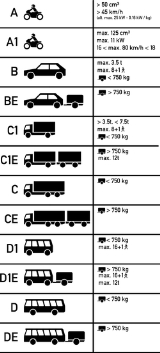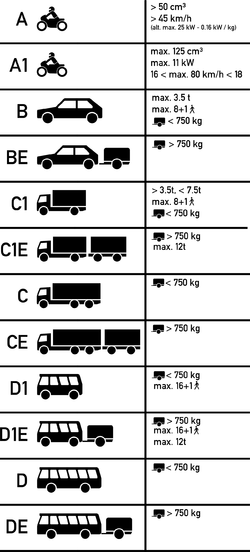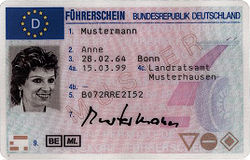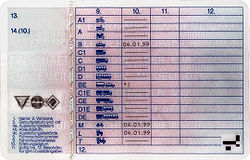
European driving licence
Encyclopedia

European Union
The European Union is an economic and political union of 27 independent member states which are located primarily in Europe. The EU traces its origins from the European Coal and Steel Community and the European Economic Community , formed by six countries in 1958...
. It has the credit card-style with a photograph and possibly a microchip
Integrated circuit
An integrated circuit or monolithic integrated circuit is an electronic circuit manufactured by the patterned diffusion of trace elements into the surface of a thin substrate of semiconductor material...
. They were introduced to replace the 110 different plastic and paper driving licences of the 300 million drivers in the EU. The main objective of the licence is to decrease the risk of fraud.
Pre-1996 European driving licence
The first step to a European driving licence was taken on 4 December 1980, when the Council of MinistersCouncil of the European Union
The Council of the European Union is the institution in the legislature of the European Union representing the executives of member states, the other legislative body being the European Parliament. The Council is composed of twenty-seven national ministers...
adopted Council Directive 80/1263/EEC on the introduction of a Community driving licence, which established a Community model national licence that guaranteed the mutual recognition by Member States of national licences. It also established the practice of exchange of licences by holders moving from one Member State to another.
European driving licence as from 1996
On 29 July 1991, the Council of Ministers adopted the Council Directive 91/439/EEC on driving licences. The directive required Member States to adopt laws implementing the directive before 1 July 1994, which laws would take effect on 1 July 1996. Directive 80/1263/EEC would be repealed on the same date. Directive 91/439/EEC currently specifies the European driving licence.Provisions
The directive harmonises the categories of driving licences among the Member States and establishes two Community driving licence models, one paper version and one plastic card version. It furthermore establishes an obligatory test of knowledge (theory) and a test of skills and behaviour (practical) which has to be successfully passed before an individual is offered a driving licence. It also requires an applicant to meet the minimum standards of physical and mental fitness to drive. The directive specifies the minimum ages for driving different types of vehicles, and establishes progressive access in categories A, C, and D, from light vehicles to larger or more powerful vehicles. The directive stipulates that it is mandatory to have the normal residence in the Member State issuing the licence.Amendments
The Directive has been substantially amended by nine directives and two acts of accession. The plastic card version of the Community licence model, for example, was added to the Directive by Council Directive 96/47/EC of 23 July 1996.New European driving licence as from 2013
In March 2006, the Council of Ministers adopted a Directive proposed by the European CommissionEuropean Commission
The European Commission is the executive body of the European Union. The body is responsible for proposing legislation, implementing decisions, upholding the Union's treaties and the general day-to-day running of the Union....
to create a single European driving licence to replace the 110 different models currently in existence throughout the EU. The European Parliament
European Parliament
The European Parliament is the directly elected parliamentary institution of the European Union . Together with the Council of the European Union and the Commission, it exercises the legislative function of the EU and it has been described as one of the most powerful legislatures in the world...
adopted the Directive in December 2006. Directive 2006/126/EEC was published in the Official Journal of the European Union
Official Journal of the European Union
The Official Journal of the European Union is the official gazette of record for the European Union . It is published every working day in all of the official languages of the member states. Only legal acts published in the Official Journal are binding.It was first published on 30 December 1952 as...
on 30 December 2006. Its provisions will take effect in 2013; Directive 91/439/EEC will then concurrently be repealed.
Provisions
The licence will be a credit-card-style, single plastic-coated document, very difficult to falsify. The document will be renewable every 10 or 15 years depending on the member state. The several member states will have the option to include a microchip containing information about the card holder on the card. This will prove extremely useful because police can access the driving licence in their own language. This would solve the problem with the three kinds of alphabet (LatinLatin alphabet
The Latin alphabet, also called the Roman alphabet, is the most recognized alphabet used in the world today. It evolved from a western variety of the Greek alphabet called the Cumaean alphabet, which was adopted and modified by the Etruscans who ruled early Rome...
, Greek
Greek alphabet
The Greek alphabet is the script that has been used to write the Greek language since at least 730 BC . The alphabet in its classical and modern form consists of 24 letters ordered in sequence from alpha to omega...
and Cyrillic
Cyrillic alphabet
The Cyrillic script or azbuka is an alphabetic writing system developed in the First Bulgarian Empire during the 10th century AD at the Preslav Literary School...
) used in the EU. In addition, the fields of the driving licence are uniformly numbered, thus allowing the police to decipher the meaning of the fields without electronic access.
Some categories like C and D will be issued for five years only. After expiration, a medical check-up is necessary in order to renew the licence for another five years.
Implementation
The directive stipulates that members states should adopt laws implementing the directive no later than 19 January 2011. Those laws should take effect in all EU members states on 19 January 2013. All licences issued before that date will become invalid by 2033.EEA relevance
The directive mentions that it has EEAEuropean Economic Area
The European Economic Area was established on 1 January 1994 following an agreement between the member states of the European Free Trade Association and the European Community, later the European Union . Specifically, it allows Iceland, Liechtenstein and Norway to participate in the EU's Internal...
relevance, meaning that its provisions in the end will also apply to Iceland
Iceland
Iceland , described as the Republic of Iceland, is a Nordic and European island country in the North Atlantic Ocean, on the Mid-Atlantic Ridge. Iceland also refers to the main island of the country, which contains almost all the population and almost all the land area. The country has a population...
, Norway
Norway
Norway , officially the Kingdom of Norway, is a Nordic unitary constitutional monarchy whose territory comprises the western portion of the Scandinavian Peninsula, Jan Mayen, and the Arctic archipelago of Svalbard and Bouvet Island. Norway has a total area of and a population of about 4.9 million...
, and Liechtenstein
Liechtenstein
The Principality of Liechtenstein is a doubly landlocked alpine country in Central Europe, bordered by Switzerland to the west and south and by Austria to the east. Its area is just over , and it has an estimated population of 35,000. Its capital is Vaduz. The biggest town is Schaan...
.
Categories valid in all EU countries
| Class | Description | Age of acquisition | Assumes | Includes | Remarks |
|---|---|---|---|---|---|
| Moped Moped Mopeds are a type of low-powered motorcycle designed to provide economical and relatively safe transport with minimal licensing requirements.Mopeds were once all equipped with bicycle-like pedals , but moped has been increasingly applied by governments to vehicles without pedals, based on their... s |
|||||
| AM (M,H) | Two-wheel vehicles or three-wheel vehicles with a maximum design speed of not more than 45 km/h and with a cylinder capacity not exceeding 50 cubic centimetres. | 16 years (15 years in Finland,Czech Republic, Slovenia, Spain and Sweden, 14 years in Estonia, Latvia, France, Italy, Portugal and Hungary). The category AM does not become EU-wide until 2013. | — | In Finland, Germany, Ireland and Norway, the class is called M. In Slovenia, the class is called H. | |
| Motorcycle Motorcycle A motorcycle is a single-track, two-wheeled motor vehicle. Motorcycles vary considerably depending on the task for which they are designed, such as long distance travel, navigating congested urban traffic, cruising, sport and racing, or off-road conditions.Motorcycles are one of the most... s |
|||||
| A1 | Motorcycles with a cylinder capacity not exceeding 125 cubic centimetres and a power not exceeding 11 kW; and motor tricycles with a power not exceeding 15 kW. | 16 years. | — | M | Recently, Portugal passed a law in which B and BE driving licencees can drive motorcycles not exceeding 125cc within Portugal. B licence holders in Latvia, Spain (Once you have a three years experience with B) and Italy are able to drive motorcycles not exceeding 125cc within the respective countries. |
| A | Any motorcycle or motor tricycle not in category A1. Limited to 25 kW and 0.16 kW/kg for 2 years. | 18, although the UK allows obtaining the license (with 25 kW / 0.16 kW/kg limit) at 17. Direct access to motorcycles over 25 kW / 0.16 kW/kg can be obtained by those 21 or over by passing "a specific test of skills and behaviour". | A1, M | ||
| Motor vehicle Motor vehicle A motor vehicle or road vehicle is a self-propelled wheeled vehicle that does not operate on rails, such as trains or trolleys. The vehicle propulsion is provided by an engine or motor, usually by an internal combustion engine, or an electric motor, or some combination of the two, such as hybrid... s |
|||||
| B | Motor vehicles with a maximum authorised mass Gross combination mass A Gross Combination Mass is the maximum allowable total mass of a fully loaded motor vehicle together with all of its trailers... not exceeding 3500 kg and designed and constructed for the carriage of no more than eight passengers in addition to the driver; motor vehicles in this category may be combined with a trailer having a maximum authorised mass which does not exceed 750 kg. |
18 years (17 years in the UK, Iceland Iceland Iceland , described as the Republic of Iceland, is a Nordic and European island country in the North Atlantic Ocean, on the Mid-Atlantic Ridge. Iceland also refers to the main island of the country, which contains almost all the population and almost all the land area. The country has a population... , Ireland Ireland Ireland is an island to the northwest of continental Europe. It is the third-largest island in Europe and the twentieth-largest island on Earth... and Hungary Hungary Hungary , officially the Republic of Hungary , is a landlocked country in Central Europe. It is situated in the Carpathian Basin and is bordered by Slovakia to the north, Ukraine and Romania to the east, Serbia and Croatia to the south, Slovenia to the southwest and Austria to the west. The... ). |
— | M, L, S | Does not include S in Norway. |
| BE | Without prejudice to the provisions of type-approval rules for the vehicles concerned, combination of vehicles consisting of a tractor vehicle in category B and a trailer or semi-trailer where the maximum authorised mass of the trailer or semi-trailer does not exceed 3500 kg. | 18 years (17 years in the UK, Germany and Ireland). | B | — | Include T in Norway. |
| Large goods vehicle Large Goods Vehicle A large goods vehicle , is the European Union term for any truck with a gross combination mass of over... |
|||||
| C1 | Large goods vehicle with a maximum authorised mass of not more than 7.5 t; with or without a trailer with a maximum mass of less than 750 kg. | 18 years | B | — | |
| C1+E | Combinations of vehicles where the tractor vehicle is in category C and its trailer or semi-trailer has a maximum authorised mass of over 750 kg. | 21 (18 in Sweden and Ireland; 18 in Germany (with limitation see class "C")) years | C | BE, C1E, D1E, DE, T | see C. |
| C | Large goods vehicle Large Goods Vehicle A large goods vehicle , is the European Union term for any truck with a gross combination mass of over... with a maximum authorised mass Gross combination mass A Gross Combination Mass is the maximum allowable total mass of a fully loaded motor vehicle together with all of its trailers... of more than 3.5 t mass and not more than 8 + 1 seats (lorry); with a trailer with a maximum mass of 750 kg. |
21 years (18 years in Bulgaria, Sweden, Finland and Ireland; 18 years in Germany for non-commercial use only except for apprenticeship as professional driver) | B | C1 | |
| C+E | Other combinations of vehicles and trailers which with combined maximum authorised mass of more than 750 kg. | 18 years | C1 | BE, D1E or DE | |
| Bus Bus A bus is a road vehicle designed to carry passengers. Buses can have a capacity as high as 300 passengers. The most common type of bus is the single-decker bus, with larger loads carried by double-decker buses and articulated buses, and smaller loads carried by midibuses and minibuses; coaches are... es |
|||||
| D | Vehicles with more than 8 + 1 seats (buses). | 21 years | B | D1 | Motor vehicles designed and constructed for the carriage of more than eight passengers in addition to the driver; motor vehicles which may be driven with a category D licence may be combined with a trailer having a maximum authorised mass which does not exceed 750 kg. |
| D1 | Light buses with a maximum of 16 + 1 seats. | 21 years | B | — | Motor vehicles designed and constructed for the carriage of no more than 16 passengers in addition to the driver.; motor vehicles in this category may be combined with a trailer having a maximum authorised mass not exceeding 750 kg. |
| DE | Combinations of vehicles where the tractor vehicle is in category D and its trailer has a maximum authorised mass of over 750 kg. | 21 years | D | BE, D1E, C1E | |
| D1E | Combinations of vehicles where the tractor vehicle is in category D1 and its trailer has a maximum authorised mass of over 750 kg. | 21 years | D1 | BE, | Includes articulated buses |
National categories
Furthermore there are more national categories for tractors, large motorcycles, motorised wheel boats, motor tricycles (modern voituretteVoiturette
Voiturette is a word mostly used to describe a miniature automobile; however, it has several nuanced meanings, depending largely on the usage date.-History:...
s, Category B1 or S) and military categories such as for driving tanks.
BF17/L17 ("Begleitetes Fahren" - Accompanied driving)
| At minor age, the driver must be accompanied by someone aged 30 and holding a valid B-license for a minimum of 5 years. Germany and Austria introduced this model a few years ago to decrease the accident rate among young drivers. BF17- (in Austria L17-) licenses are just approved in Germany and Austria. When the driver reaches legal age BF17/L17-licenses are transcribed to regular B-licenses.
Switzerland
Since the 2000s, SwitzerlandSwitzerland
Switzerland name of one of the Swiss cantons. ; ; ; or ), in its full name the Swiss Confederation , is a federal republic consisting of 26 cantons, with Bern as the seat of the federal authorities. The country is situated in Western Europe,Or Central Europe depending on the definition....
uses the EU system of vehicle categories, issues EU-style credit-card licences and has generally adopted much of the harmonised EU legislation with regard to drivers' licences.
To apply for a car driver's licence (category B), the applicant must be 18 years old. They must first attend first aid courses and pass have their view checked by an eye-doctor. Passing a theoretical exam is required to receive a learner's permit
Learner's permit
A driver's permit, learner's permit or learner's license, is a restricted license that is given to a person who is learning to drive, but has not yet satisfied the requirements to obtain a driver's license...
valid for two years. This allows them to drive a car only if accompanied by an adult 23 or older who has had his licence for at least 3 years. Before passing the practical exam, the candidate must attend 10 hours of theoretical lessons on "sensibilisation to road traffic".
Practical driving lessons are not legally required, but are considered a de facto prerequisite for passing the practical exam with a government expert.
Upon succeeding the practical exam a probationary driver's licence is issued for 3 years. To obtain the full, unlimited, driver's licence after these 3 years, the candidate must not commit a serious traffic infraction and attend 2 days of further driving training.
For motorcycles and heavier vehicles, the regulations are different, and some agrarian vehicles can be driven without a licence. As of 2011, a 45-minute driving lesson costs around 90 CHF, while the various fees and theoretical instruction costs associated with getting a car driver's licence can amount to up to CHF 600, without counting the costs for the two days of further training.
The theoretical exam must be taken in either German
German language
German is a West Germanic language, related to and classified alongside English and Dutch. With an estimated 90 – 98 million native speakers, German is one of the world's major languages and is the most widely-spoken first language in the European Union....
, French
French language
French is a Romance language spoken as a first language in France, the Romandy region in Switzerland, Wallonia and Brussels in Belgium, Monaco, the regions of Quebec and Acadia in Canada, and by various communities elsewhere. Second-language speakers of French are distributed throughout many parts...
or Italian
Italian language
Italian is a Romance language spoken mainly in Europe: Italy, Switzerland, San Marino, Vatican City, by minorities in Malta, Monaco, Croatia, Slovenia, France, Libya, Eritrea, and Somalia, and by immigrant communities in the Americas and Australia...
. In some cantons it is possible to take it in English
English language
English is a West Germanic language that arose in the Anglo-Saxon kingdoms of England and spread into what was to become south-east Scotland under the influence of the Anglian medieval kingdom of Northumbria...
.
Norway
While not a member of the European Union, Norway uses EU vehicle categories and issues EU-style credit-card licences, with the following deviations:- In addition to the standard EU items, the bearer's national identification numberNational identification numberA national identification number, national identity number, or national insurance number is used by the governments of many countries as a means of tracking their citizens, permanent residents, and temporary residents for the purposes of work, taxation, government benefits, health care, and other...
is included as item 4d). - Vehicle category A2 is not used.
- There are three additional vehicle categories: M for mopedMopedMopeds are a type of low-powered motorcycle designed to provide economical and relatively safe transport with minimal licensing requirements.Mopeds were once all equipped with bicycle-like pedals , but moped has been increasingly applied by governments to vehicles without pedals, based on their...
s, S for snowmobileSnowmobileA snowmobile, also known in some places as a snowmachine, or sled,is a land vehicle for winter travel on snow. Designed to be operated on snow and ice, they require no road or trail. Design variations enable some machines to operate in deep snow or forests; most are used on open terrain, including...
s and T for tractorTractorA tractor is a vehicle specifically designed to deliver a high tractive effort at slow speeds, for the purposes of hauling a trailer or machinery used in agriculture or construction...
s.
Sample licence
| German version of a current EU driving licence | ||
|---|---|---|
 |
 |
|
http://www.bmvbs.de/Verkehr/Strasse/EU-Fuehrerschein-,1447.1041640/Welche-Daten-enthaelt-ein-Fueh.htm
See also
- Driving Licence
- European Commissioner for TransportEuropean Commissioner for TransportThe Commissioner for Transport is the member of the European Commission. The current commissioner is Siim Kallas.The portfolio is responsible for the development of transport infastructure in the European Union such as road and rail networks but also navigation systems such as the Galileo...
- International driving licence
External links
- http://www.workpermit.com/news/2006_12_18/eu/european_driving_license.htm
- http://ec.europa.eu/idabc/en/document/3826/330
- http://www.euractiv.com/en/transport/single-europe-wide-driving-licence-2013/article-160496
- http://news.bbc.co.uk/2/hi/europe/6180617.stm
- http://www.direct.gov.uk/en/Motoring/DriverLicensing/WhatCanYouDriveAndYourObligations/DG_4022547

